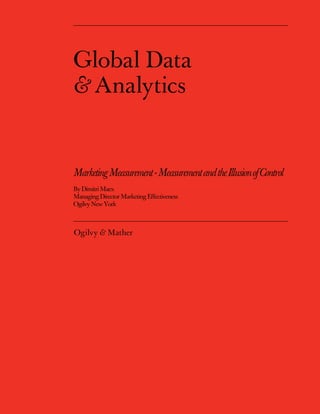
Measurement and the Illusion of Control
- 1. Global Data & Analytics Marketing Measurement - Measurement and the Illusion of Control By Dimitri Maex Managing Director Marketing Effectiveness Ogilvy New York Ogilvy & Mather
- 2. Measurement and the illusion of control There are two sides to every company - the supply side and the demand side. The supply side is the one companies control. They can turn the dials, push the buttons and know almost exactly what the result will be. They buy a new machine and know how much their productivity will go up. The demand side, on the other hand, companies don’t control. It is controlled by consumers. It’s the fuzzy side where cause and effect are not always clear. It’s the world of marketing. Finding out what happens when you turn the dials and push the buttons on the demand side is the art of marketing effectiveness. So how does marketing create demand? The always insightful, to the point and practical Tim Ambler provides a very high level framework of how marketing creates demand in Marketing and the Bottom Line : Today Tomorrow Environment Environment Category Category Competitor Competitor Marketing Mix Behavior Behavior A marketing activity today will be processed in our heads and modified by perceptions of the environment, the category and what our competitors are doing. This may or may not affect behavior. Memories of the marketing activity and the brand experience if behavior was affected will be stored in our heads tomorrow. This is what Ambler calls Brand Equity - what is stored in our heads about a brand. He says Brand Equity supports the business because it stores what marketing has achieved but has not yet reached the profit and loss account. This is a very simple framework that conceals a lot of the complexity of how marketing works. There are no absolute rules that can explain with a high degree of certainty how we process marketing information, how that is affected by other external perceptions (or peers), how it affects behavior and how what is in our heads today about a brand will affect our behavior tomorrow and beyond. These are all relative unknowns and it is the role of marketing measurement and analysis to get a better understanding of how this process works. This insight will enable the marketer to make better marketing decisions today. But because of the complexity, irrationality and unpredictability of consumer behavior there will
- 3. always be a high degree of fuzziness around what the future behavior will be as a result of marketing activity today. Many non marketing executives feel uncomfortable with the fuzziness of marketing. They spend most of their time on the supply side of the business where there is very little fuzziness and where the return on an investment can usually be quantified relatively easily. It therefore shouldn’t come as a surprise that they have asked marketing for more clarity on (accountability of) what the impact is of their efforts. Marketing’s response has been to try and use supply side financial techniques to do this. The most popular one would be to estimate the discounted cash flow of future revenue streams that will be generated as a result of current brand equity. The complexity of fig 1 described earlier clearly shows that getting an accurate estimate of this is nearly impossible. This is however the main technique used to calculate Brand Value (often confused with Brand Equity itself). By trying to use supply side language to describe the complex dynamics of the demand side of the business, marketers have chosen a wrong and potentially dangerous path. Ambler writes : Important as financial metrics are, they distort reality and provide the illusion of control. Cannabis does much the same. Giving non marketing executives the illusion that the demand side of the business can be explained by financial metrics is counter productive. It gives them the excuse to treat marketing as a black box they can invest in and expect a positive return from without really having to understand its inner workings. Marketing measurement should do the exact opposite. Rather than reducing the entire process to one or 2 financial metrics, it should create transparency and thereby force non marketing executives to acknowledge the complexity of how demand is created. This can be done using a combination of financial metrics such as sales, investment and bottom line and brand equity indicators such as awareness, consideration, penetration, loyalty and brand image and perceptions. Measurement that creates transparency around how demand is created can be extremely powerful. It should never be shy to expose the complexity of the process by which demand is generated and the fuzziness that comes with it. Very few marketing organizations do this well. And if the marketing community can’t explain clearly how demand is created, it’s hard to blame non marketing executives for wanting to try to do it using crude financial metrics.
